An agenda establishes the goals of a meeting: what will be covered in the meeting, how it will be conducted, and how much time will be spent during it. Regular meetings are usually an essential part of a team’s success. They are often used to set strategies, resolve problems, and discuss important topics that directly or indirectly affect the team’s performance.
Whether you are a team leader or have been asked to set the agenda for a meeting, it is essential to know what should be included in it, what format will serve you best, and how to present it adequately. This article will take you through everything you need to know about meeting agendas, including their purpose, main points, and how to create the perfect one. Free downloadable templates will also be provided in this article.
Why Should We Create a Meeting Agenda?
In most cases, the purpose of a meeting agenda is to provide clear directions and an effective means to communicate what needs to be discussed for the team to accomplish its goals. It ensures that everyone on the team understands what needs to be done and what is expected. In addition, it provides structure and order. It helps avoid confusion among team members by clearly describing any sensitive issues or topics that might arise during the meeting. A well-structured agenda also helps specify how each team member can be involved in creating a solution to issues raised during the meeting.
It will also specify if the meeting will be remote or if a physical presence will be required for the team members. It also gives an idea of the duration and objective of the meeting.
Key Points to Include in a Team Meeting Agenda
Even though meetings should be interactive and participants should actively discuss the topics, having an agenda with clear discussion items can help make them more productive and efficient.
The participants can refer to these points to direct the discussion, thereby avoiding distractions and losing focus. This allows participants to focus their ideas and thoughts on issues that need to be discussed.
Some of the key points that you may consider including are the following:
- Challenges and issues faced by the team
- Strategies and plans to be used to meet the objectives
- What each member can do to help implement change
- News and announcements that affect the team or organization
- What will everyone do to ensure that the meeting has a productive outcome?
- Deadlines and key performance indicators (KPIs) for each project
Free Templates for Team Meeting Agenda
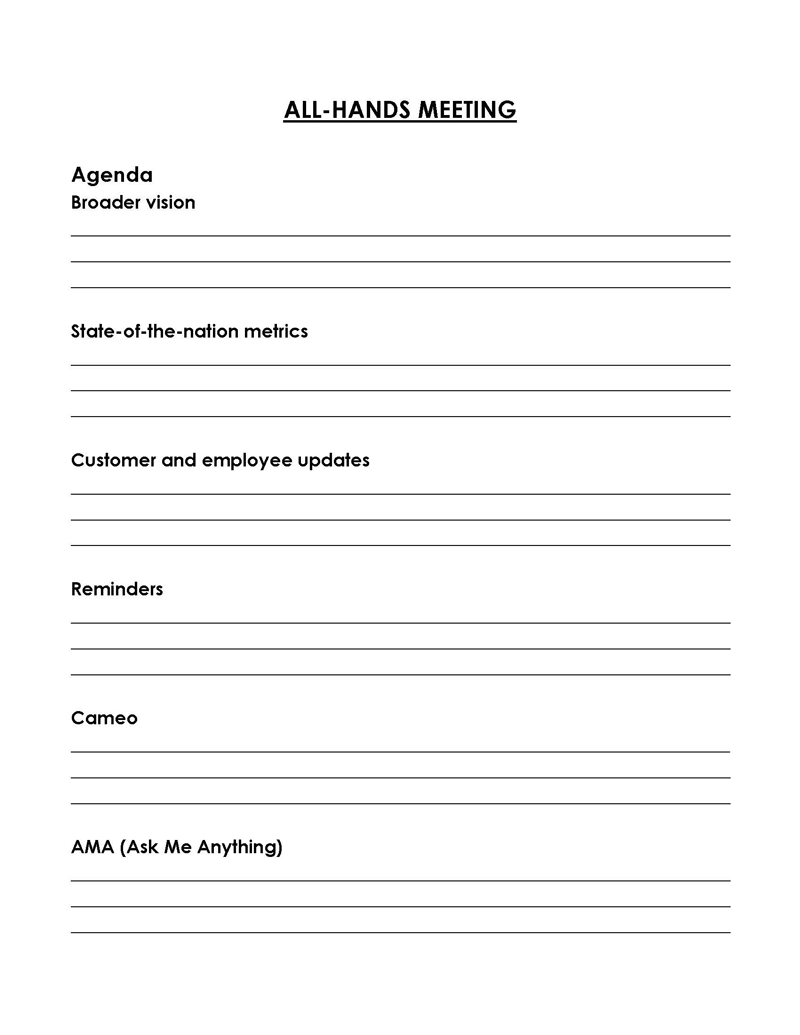
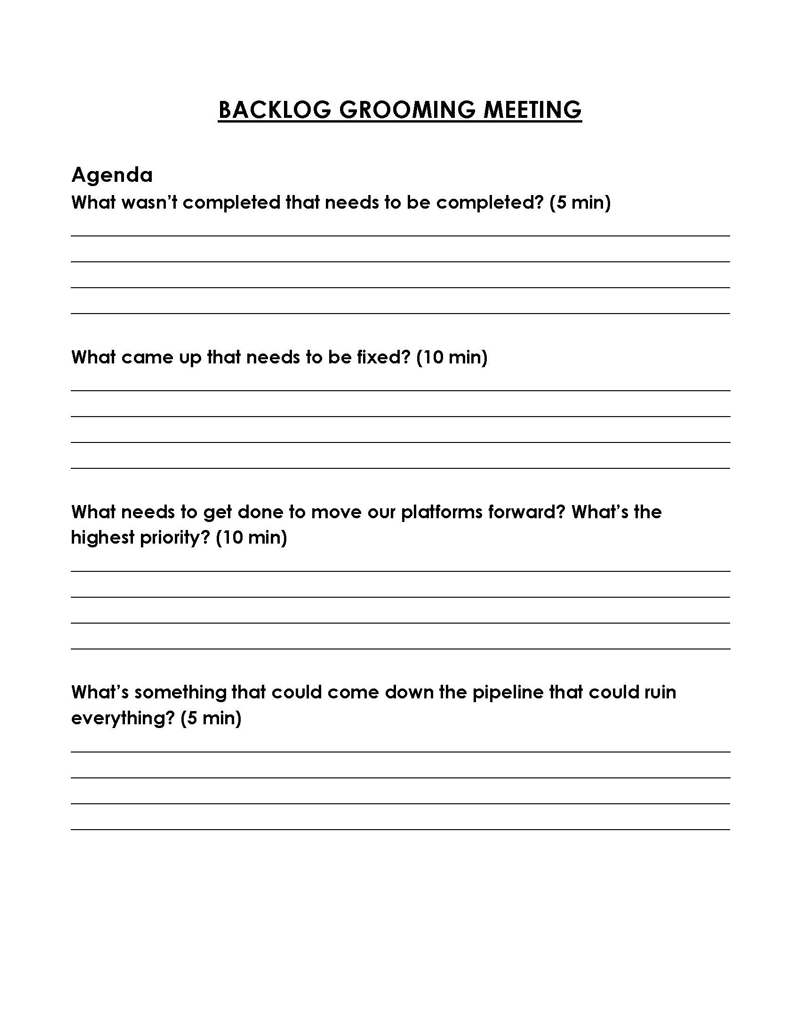
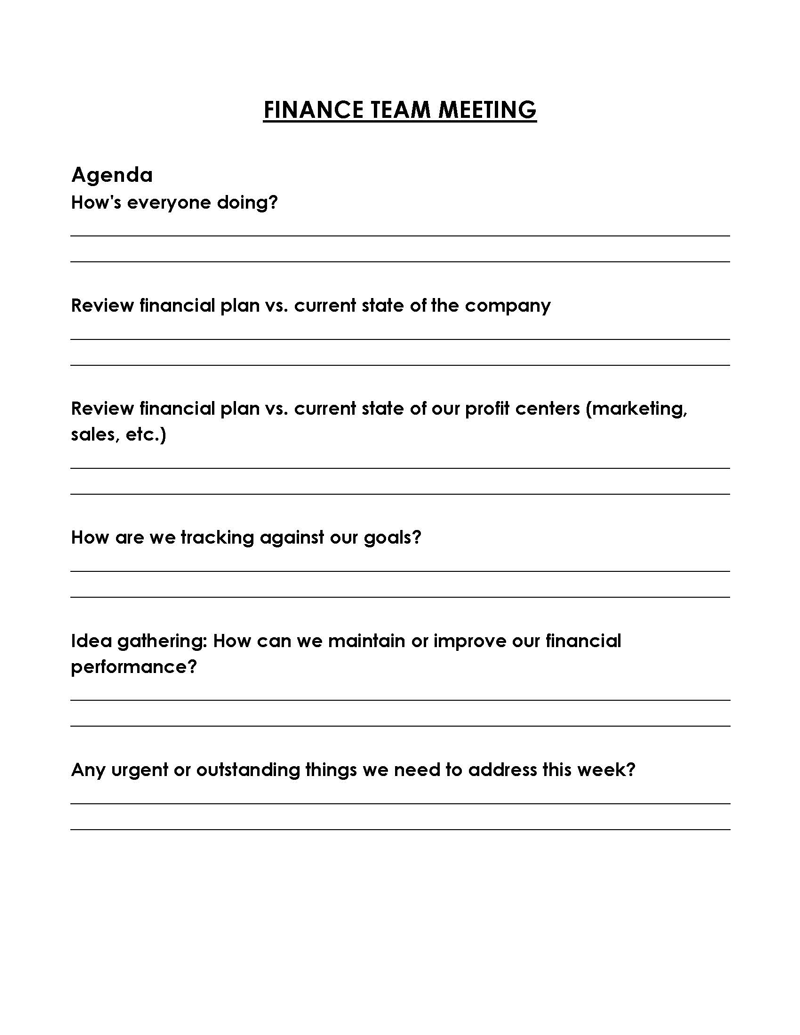
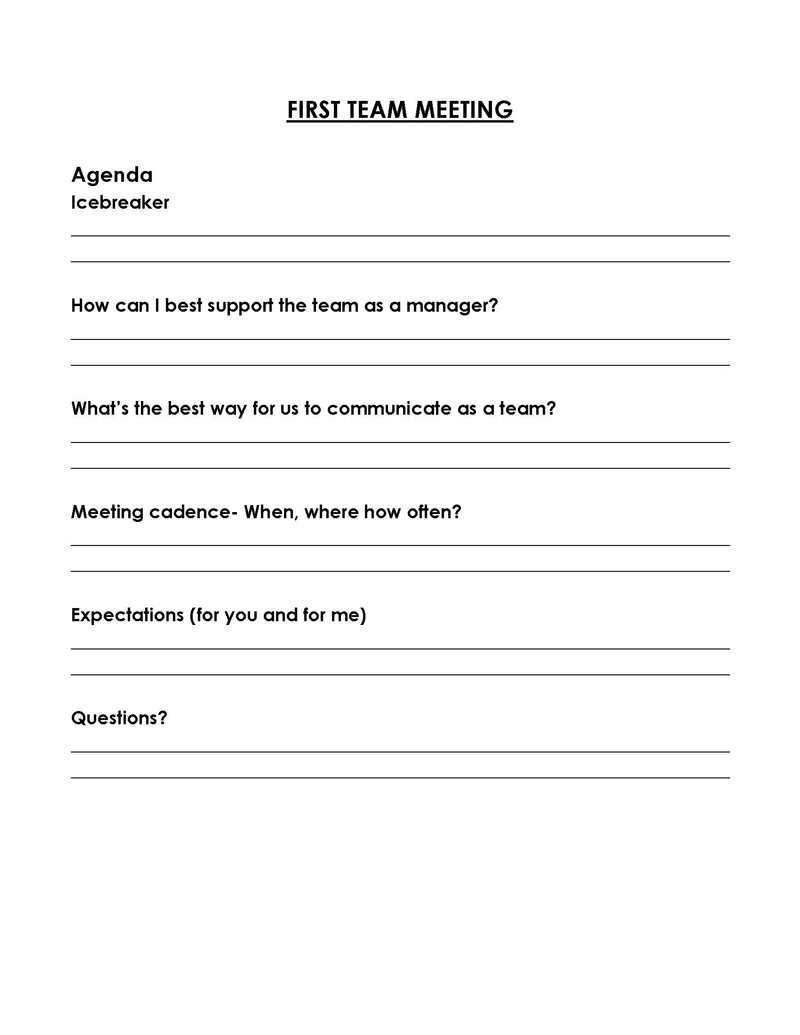
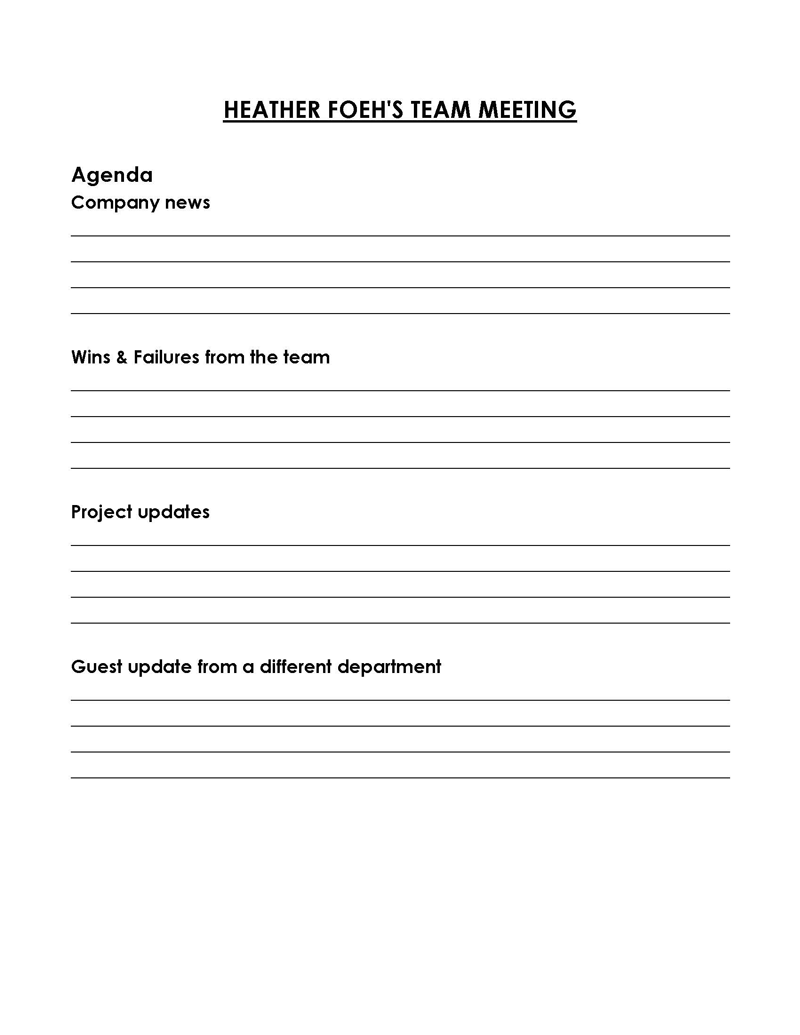
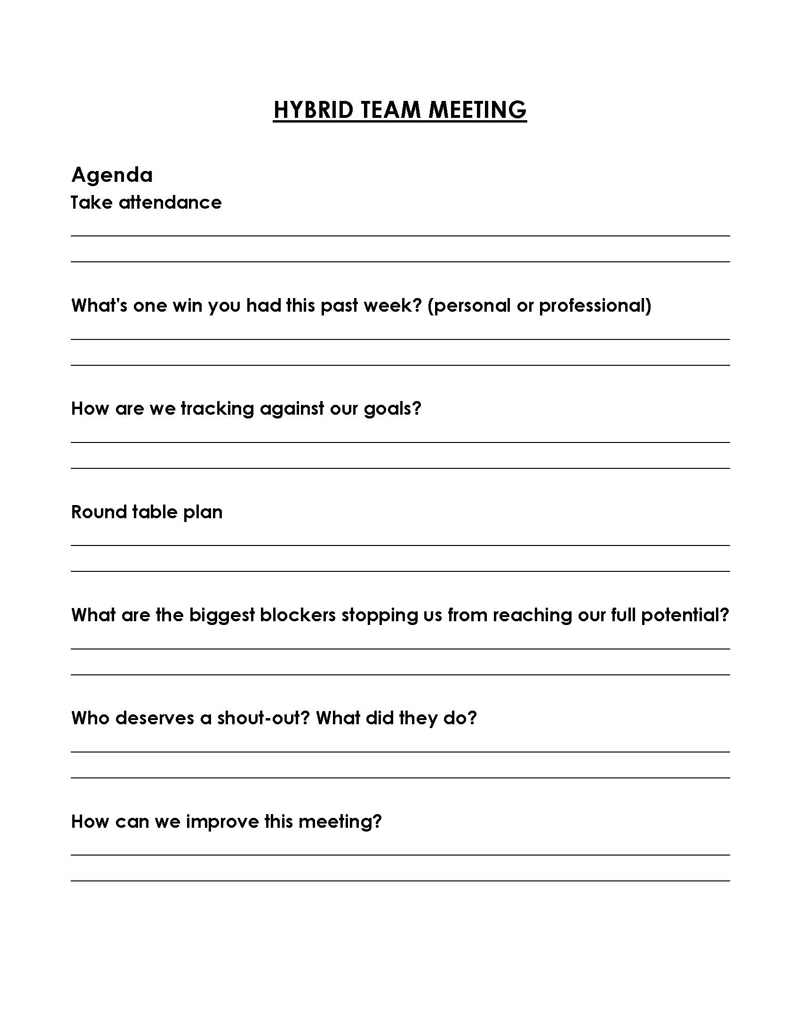
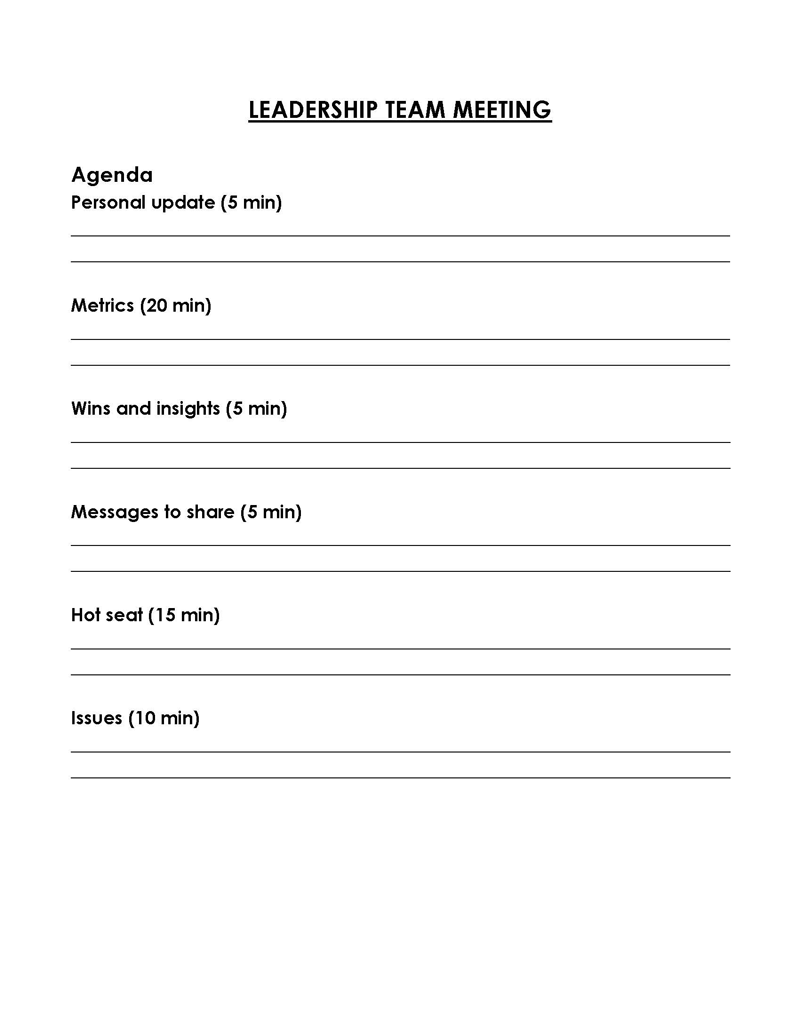
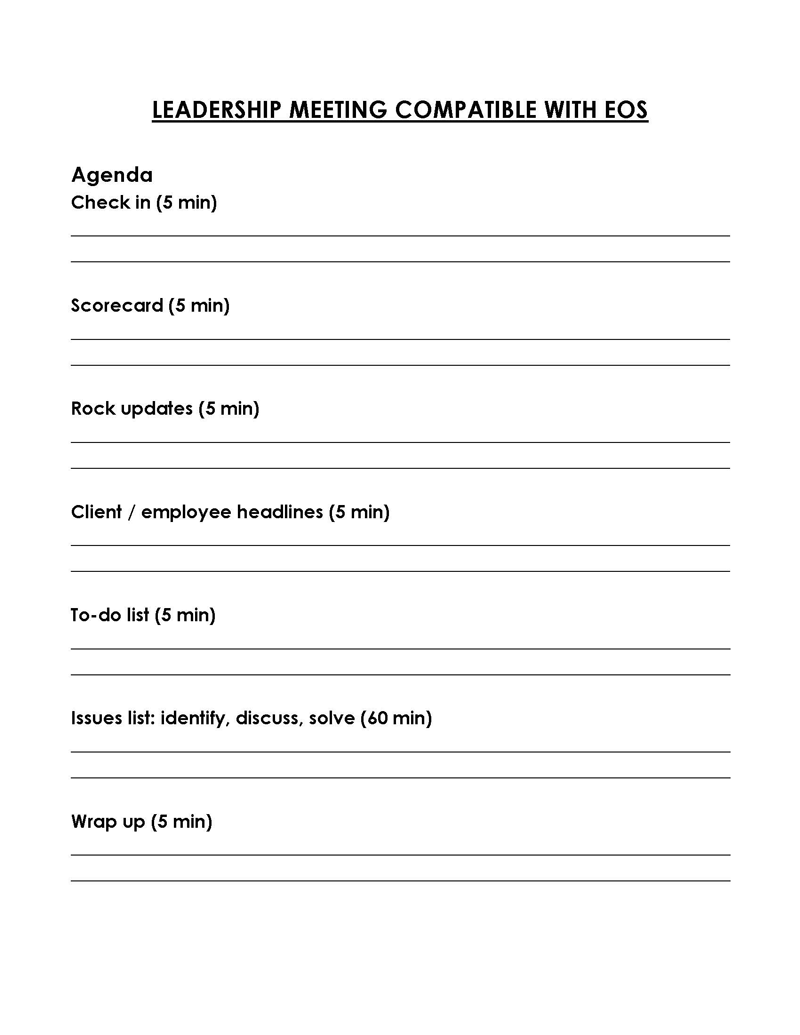
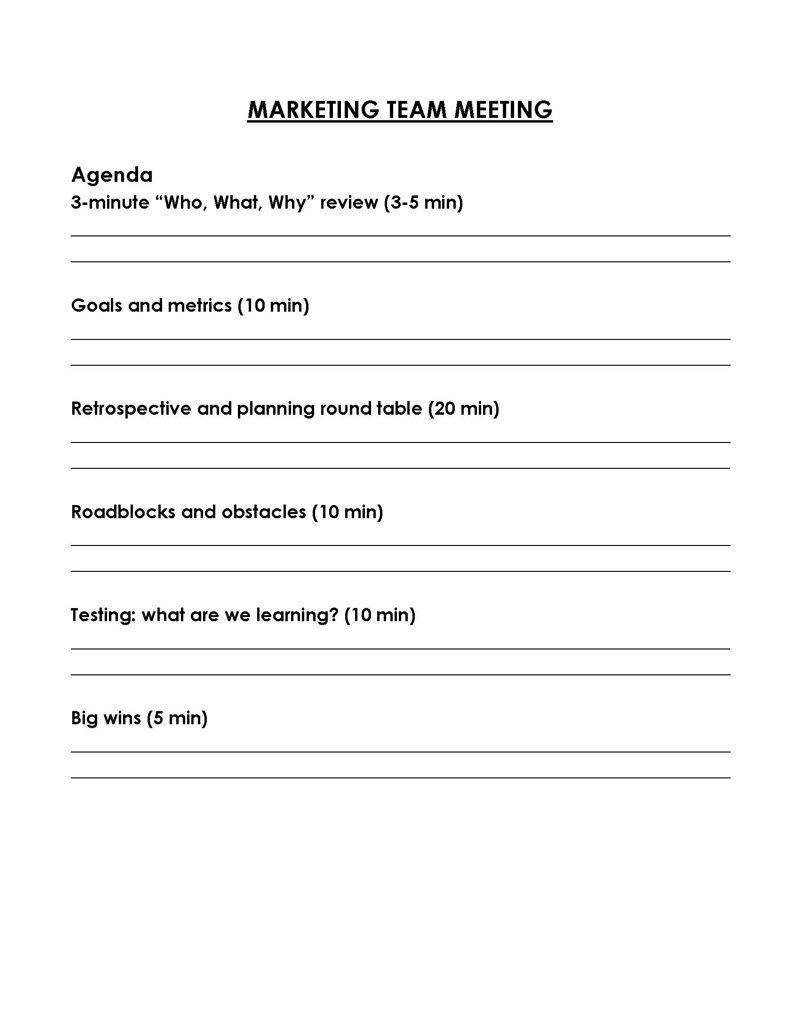
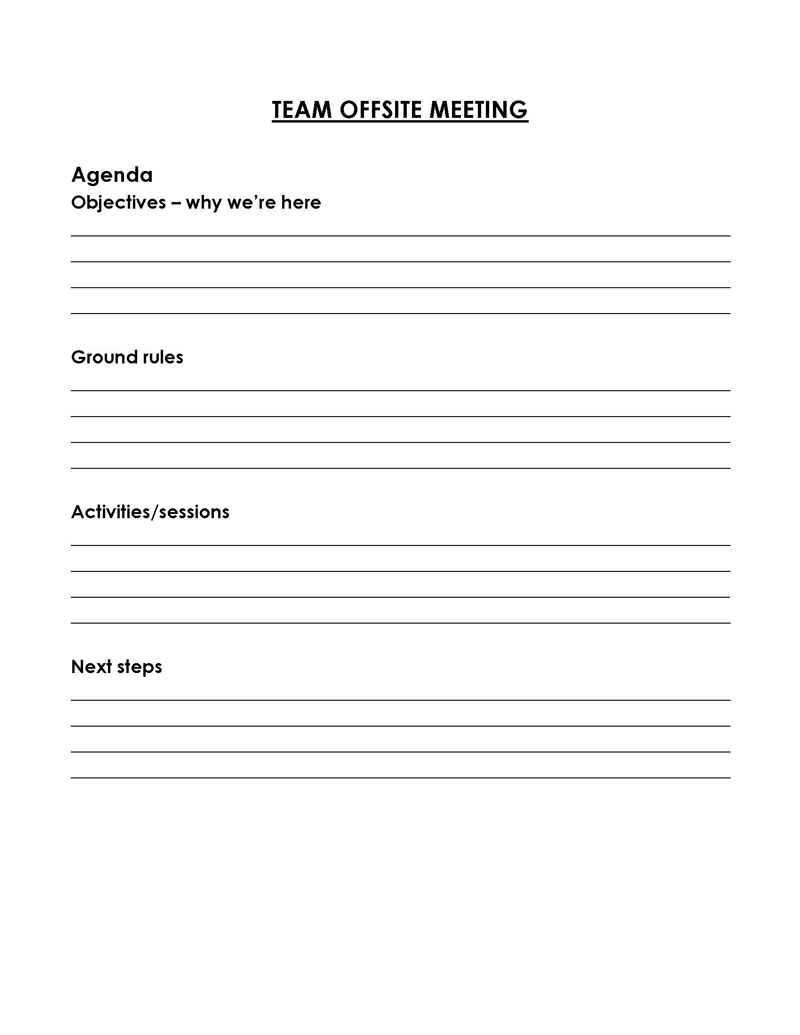
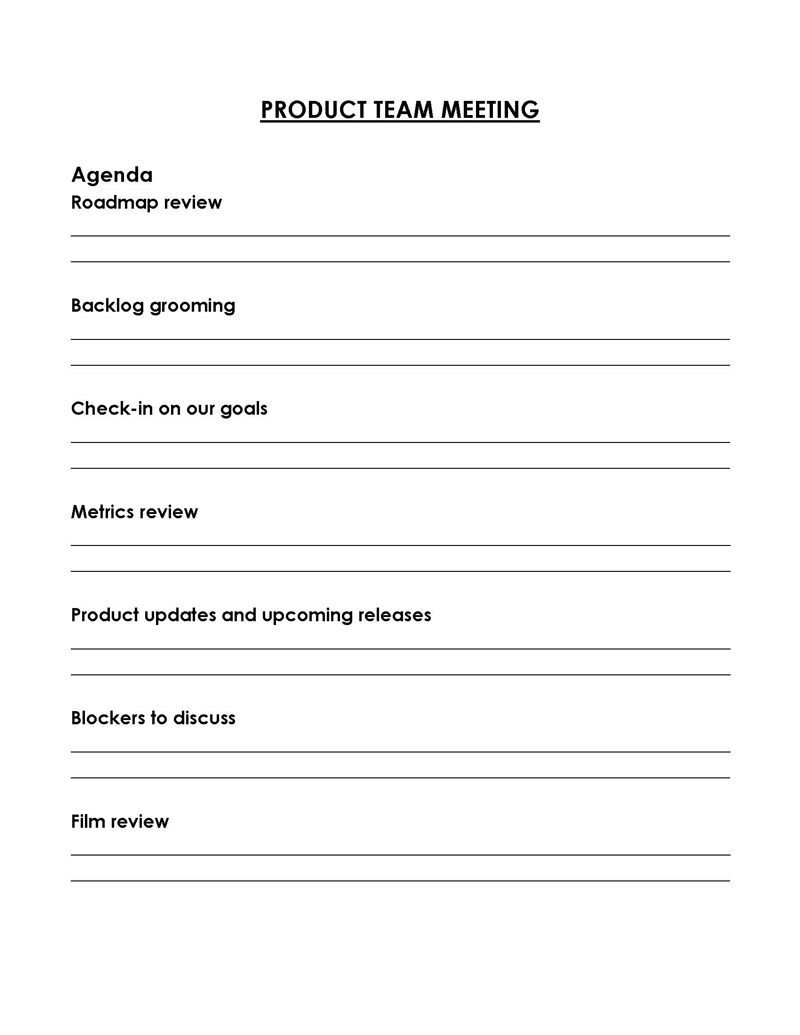
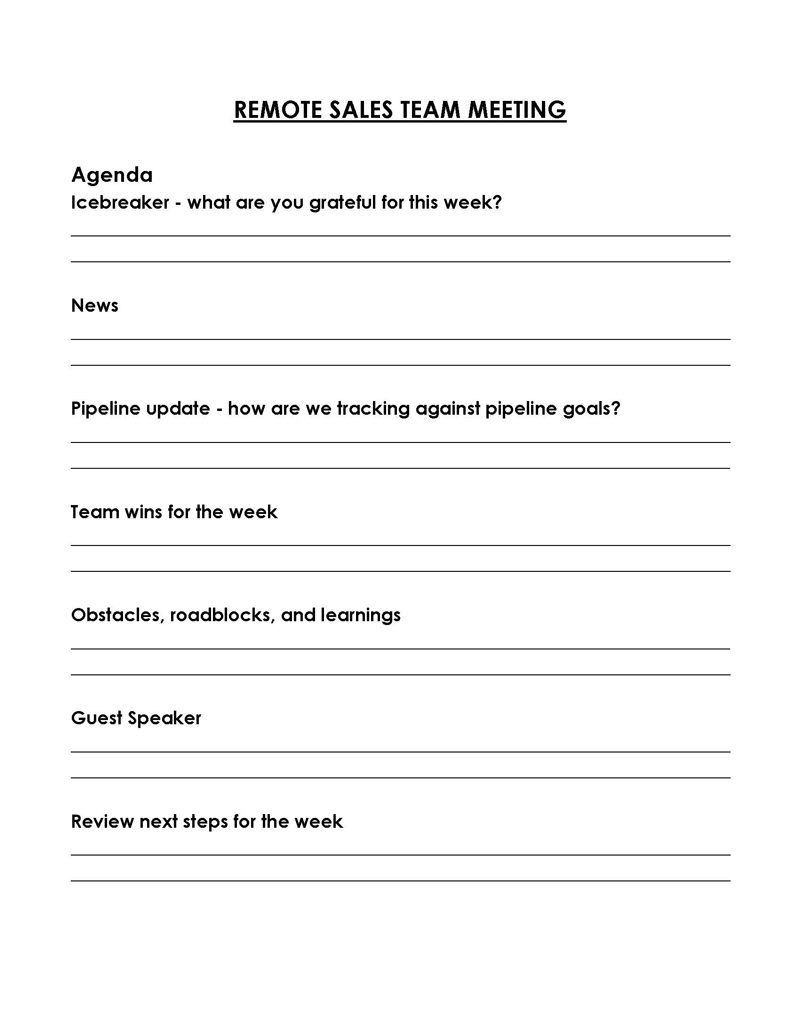
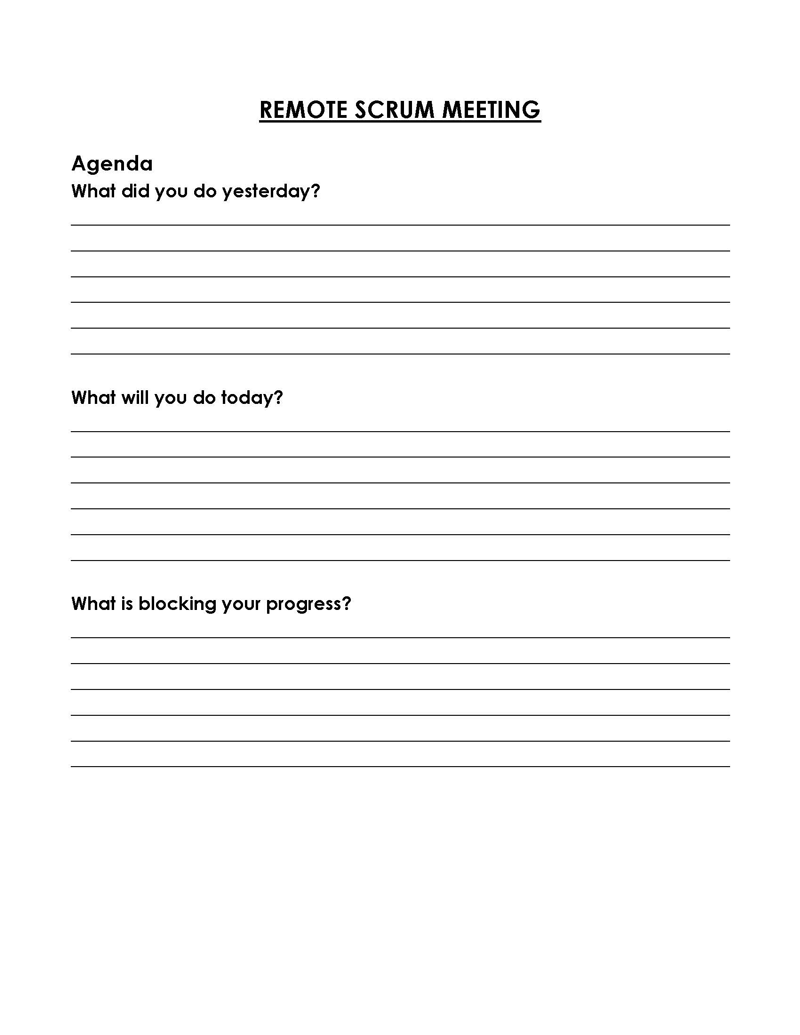
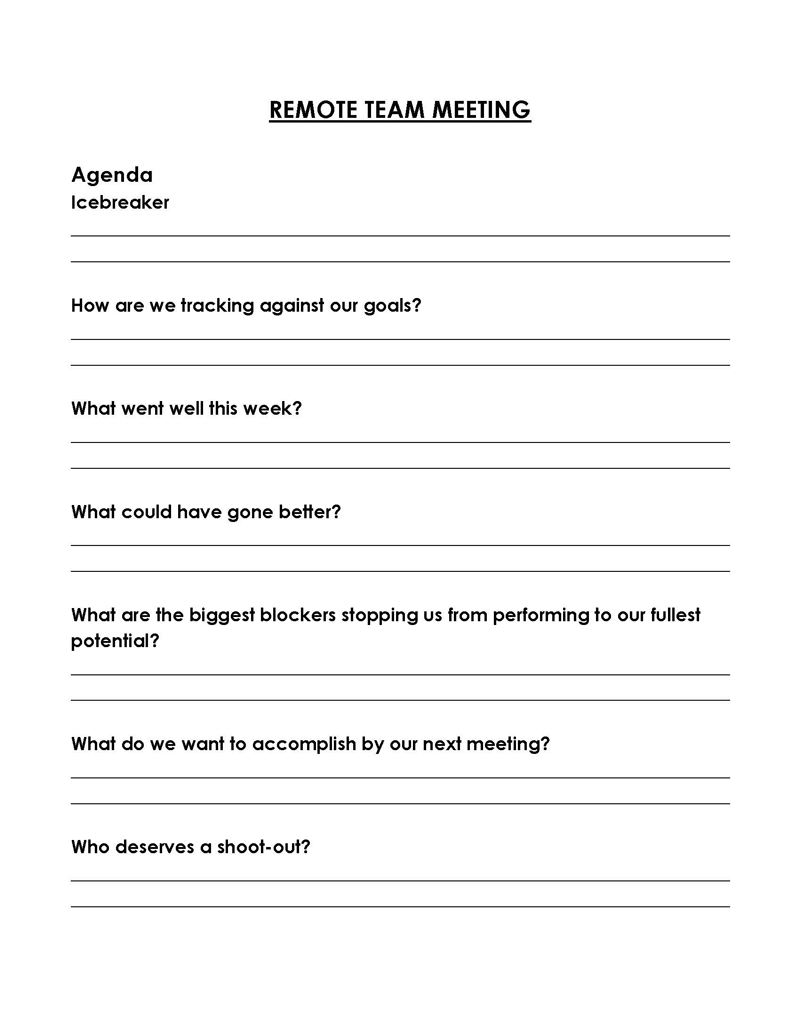
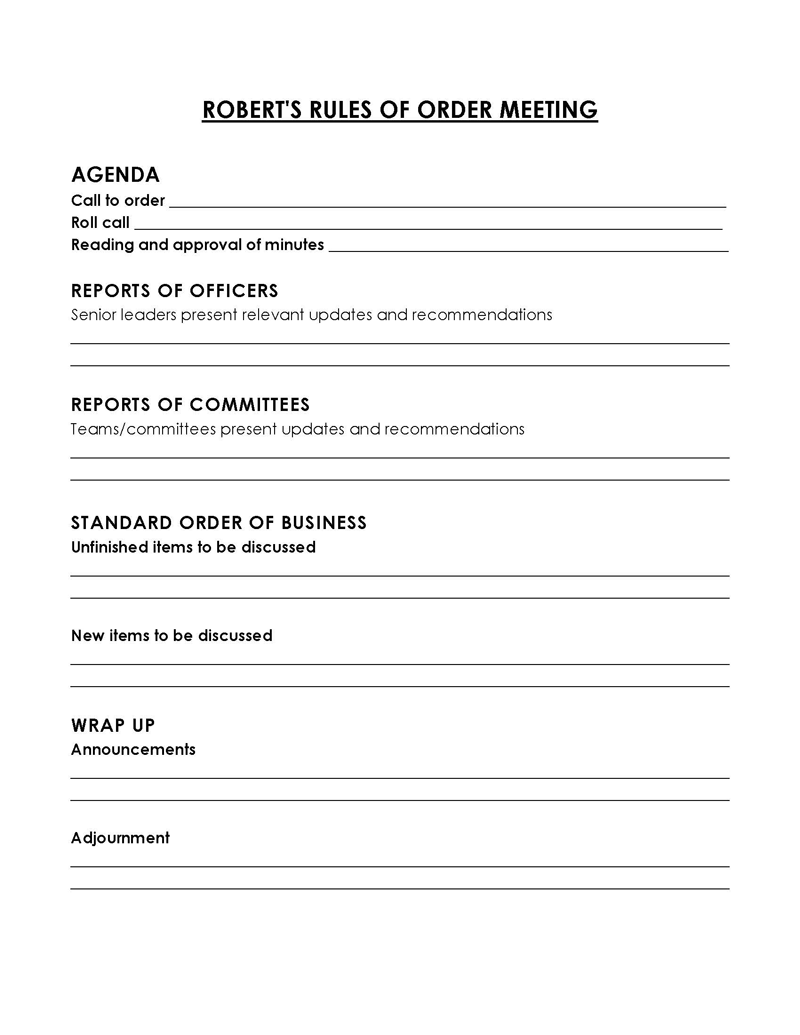
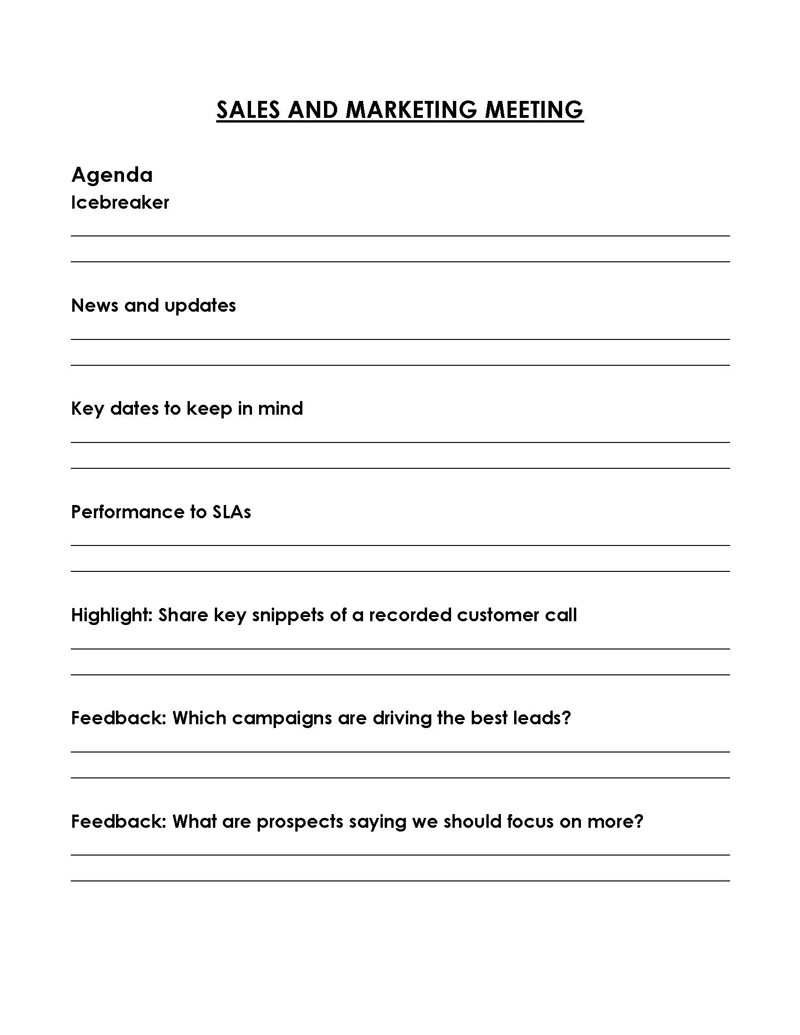
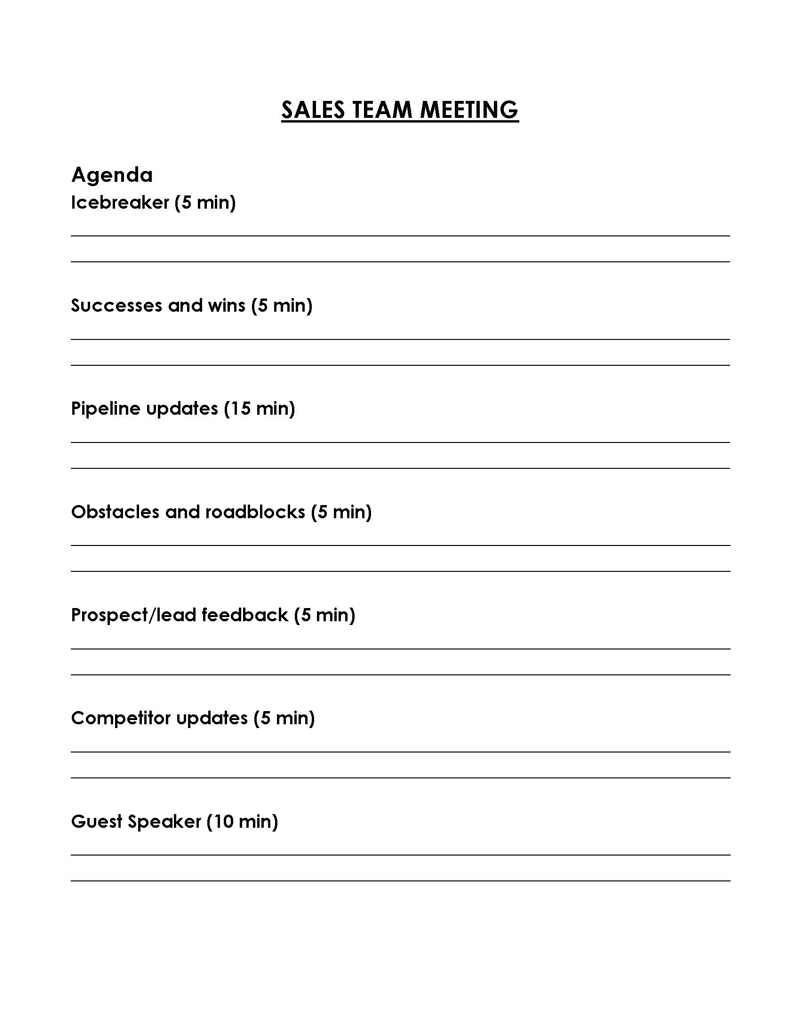
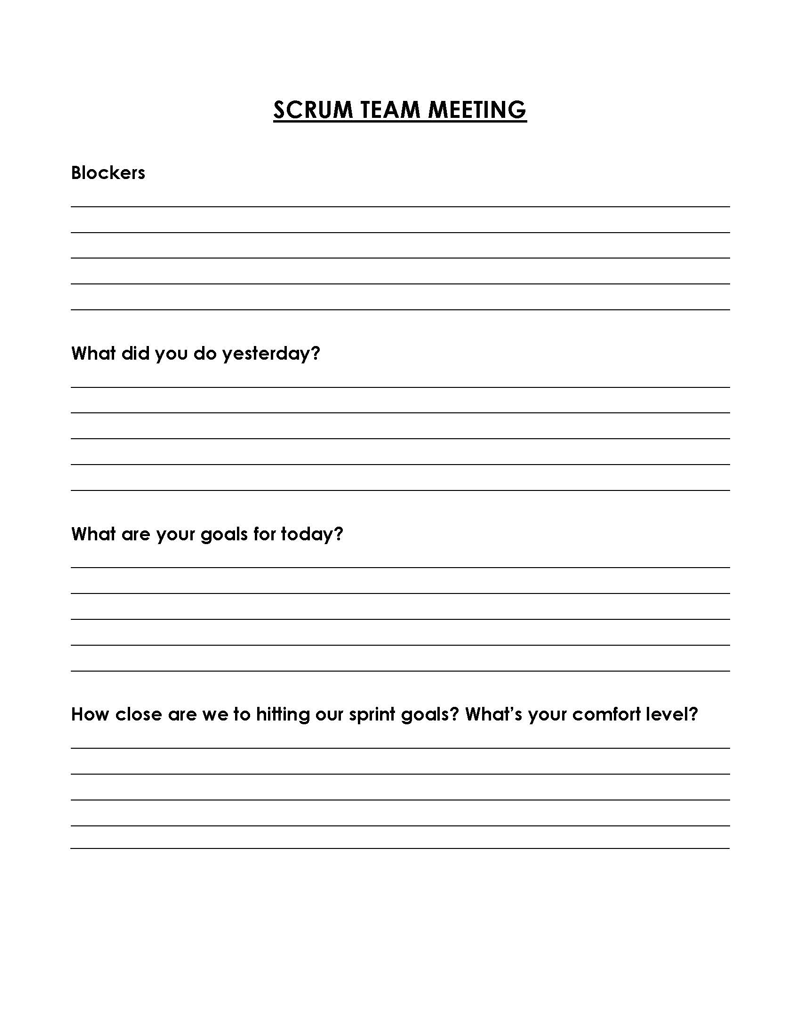
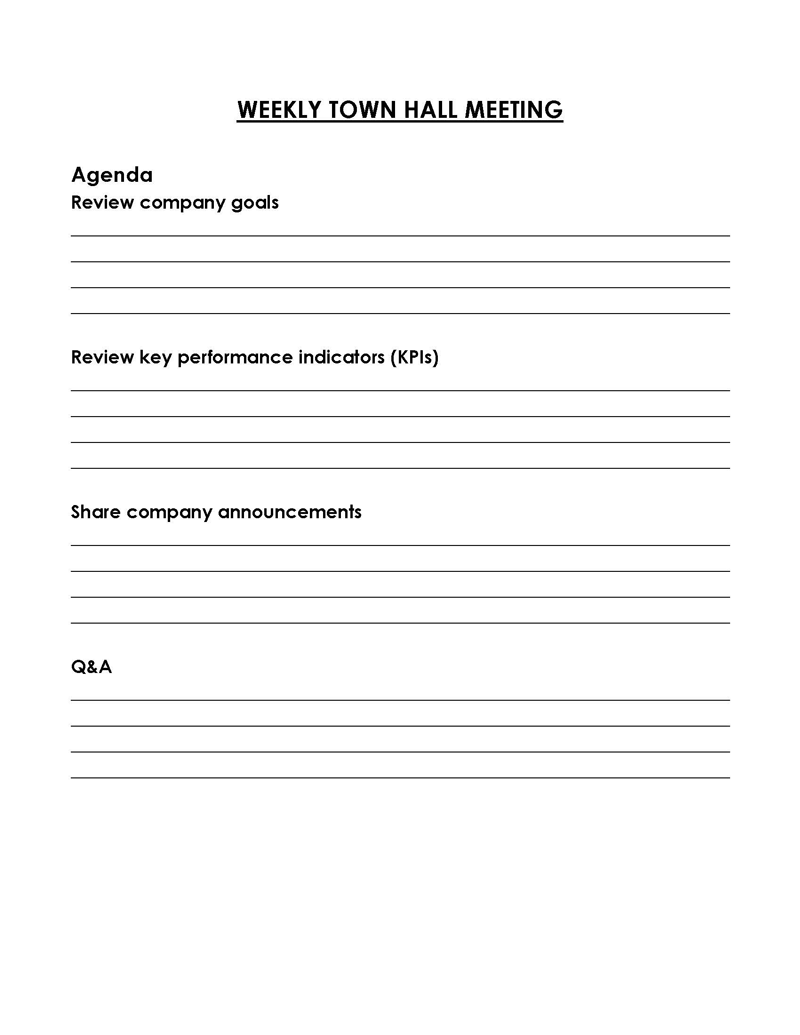
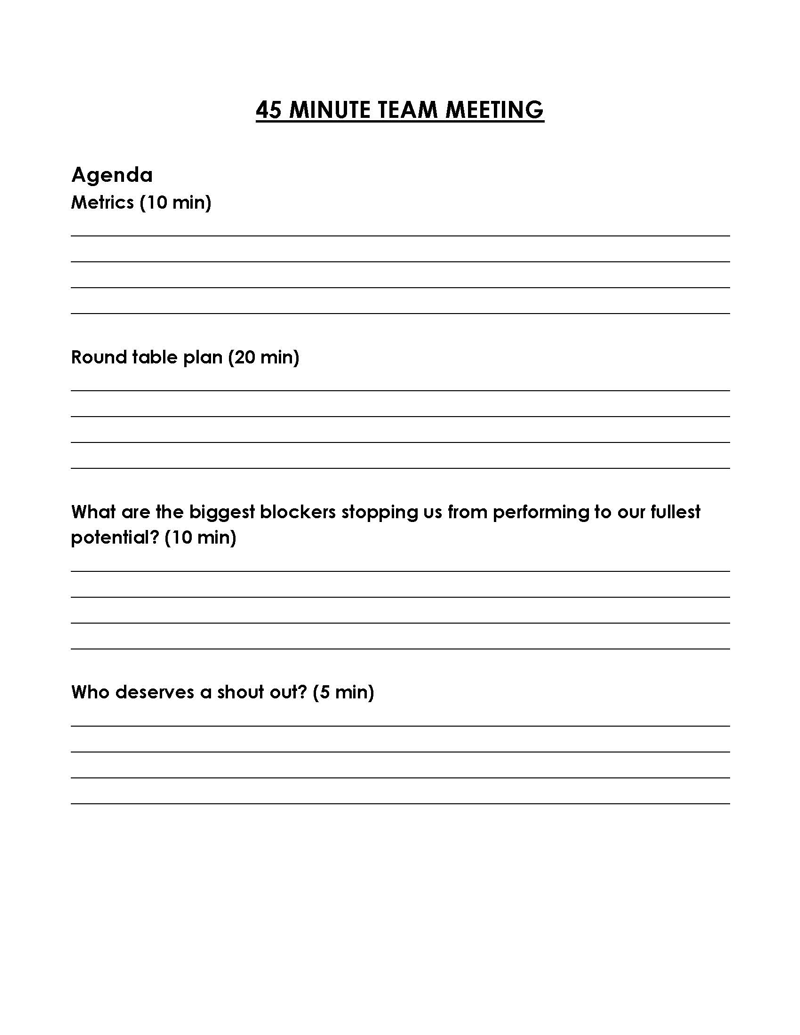
How to Create a Team Meeting Agenda
As a team leader or chairperson, it is essential to know how to craft an efficient meeting agenda to help you communicate the team’s overall performance, define expectations, and focus on the central issues.
This section will guide you through everything you need to know to create a meeting agenda properly.
Think about the objectives
When planning the meeting, you must consider what you want to accomplish. The first step is to set a goal for what you want to achieve. What are your objectives? Do you want to discuss a project’s progress and upcoming events or get a chance to hear feedback from the team? The answers to all these questions should help you craft a clear objective.
When setting the objectives, they should be three-fold: the overall purpose of the meeting, the main points you need to cover, and the period for achieving each objective. Once you have determined your objectives, you should proceed to the next step.
List and organize agenda items
Next, you need to organize your agenda items to help the team stay focused. You may also consider using the STAR (Situation, Task, Action, and Result) method. This method is one of the ideal ways to help you organize the items for the meeting so everyone can easily understand the meeting’s objectives.
You should also list the items and organize them according to priority. Consider what information you want to cover at the beginning, middle, and end of the meeting. If there are a lot of items, you might think about including many of them in breakout sessions.
bonus tip
To better engage the participants and set up a conversation about certain topics, it is recommended that when preparing the agenda, instead of listing the items as bullet points, you list them as questions. For instance, instead of writing “Training for new employees,” write “What are the optimal training hours for new employees?” or “What training should we offer to new employees?” This will help you get the information you need quickly and easily. This will also help the participants clearly understand why you need to gather this information and allow them to stay focused during the meeting.
Estimate and list the time for each topic
One of the essential steps in creating an influential agenda is setting a time for each topic. Ensuring that each item is allotted enough time will ensure everyone has time to discuss and contribute without feeling rushed.
tip
Avoid including too many items. The more items you include, the more likely a participant will be unsure of what is supposed to be discussed, leading to less discussion and less productivity.
Mention the process for the discussion of any agenda item
Agreeing on the process of discussing the agenda items is an essential step toward effective meetings. It should be able to specify the process of discussing each item. It is essential to clearly state how you want each item to be addressed- whether through a breakout session, a brainstorming session, or an open forum exchange. Clearly stating the process in advance will save time during the meeting.
For instance, if you are hosting a meeting to discuss new SEO strategies, the process may look something like this:
- Brainstorm SEO opportunities for your site
- Break into smaller groups based on your interests
- Discuss and present ideas to the larger group
- Outline specific strategies for implementation
- Schedule and assign tasks for the execution of the tasks of the project
A process like this will allow each person to express their opinion, provide input from the entire team, and keep the meeting moving toward an actionable plan.
List participants
Having a meeting agenda is not enough. It is also vital to have the right participants to achieve the desired results. Therefore, the first thing you should think about when making a decision about the participants is to identify any team members who might be hesitant to participate in an open discussion or who might feel they don’t know enough about particular topics.
tip
When creating the participant list, you must consider including team members who may not be directly affiliated with the meeting or project, but may be able to provide valuable insight into some issues.
Clarify the roles and responsibilities of the participants
It is essential to state the roles and responsibilities of each team member clearly. Without clearly stating the roles and responsibilities, there may be little discussion and a lack of productivity.
EXAMPLE
If the meeting has several breakout sessions in which each team member can participate, you should ensure that each person is assigned a specific role. To select the roles properly, you should consider their expertise in the field.
Assign next steps
Once you have finalized the agenda’s structure and list of participants, assigning the next steps, otherwise known as action items, is essential. An action item is a specific activity or task that needs to be completed to achieve a specific goal. The action items should directly relate to the meeting’s objectives, such as clarifying the next steps for team members working on the project, assigning deadlines for tasks, and discussing potential problems that might occur.
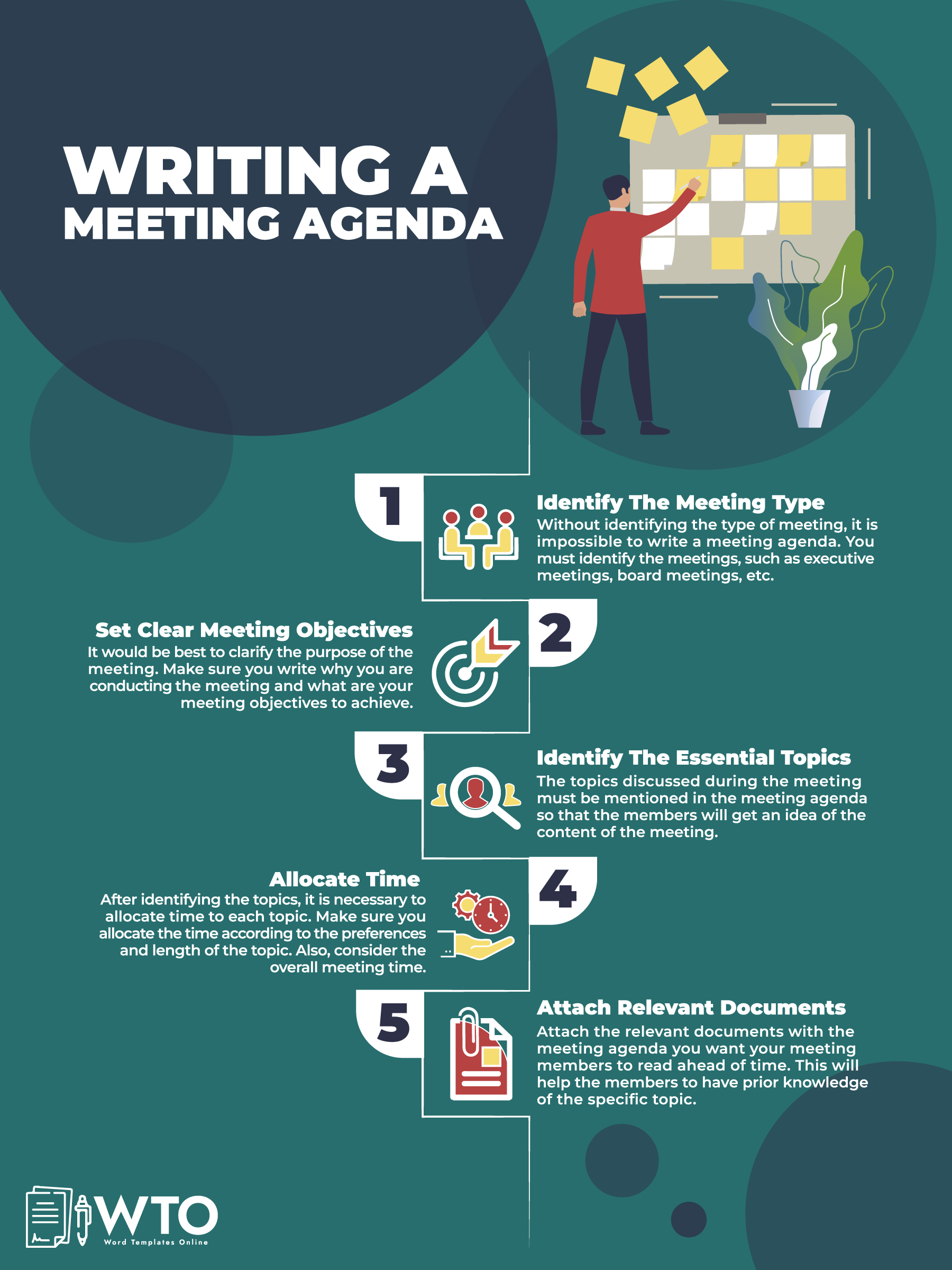
Meeting Agenda Examples
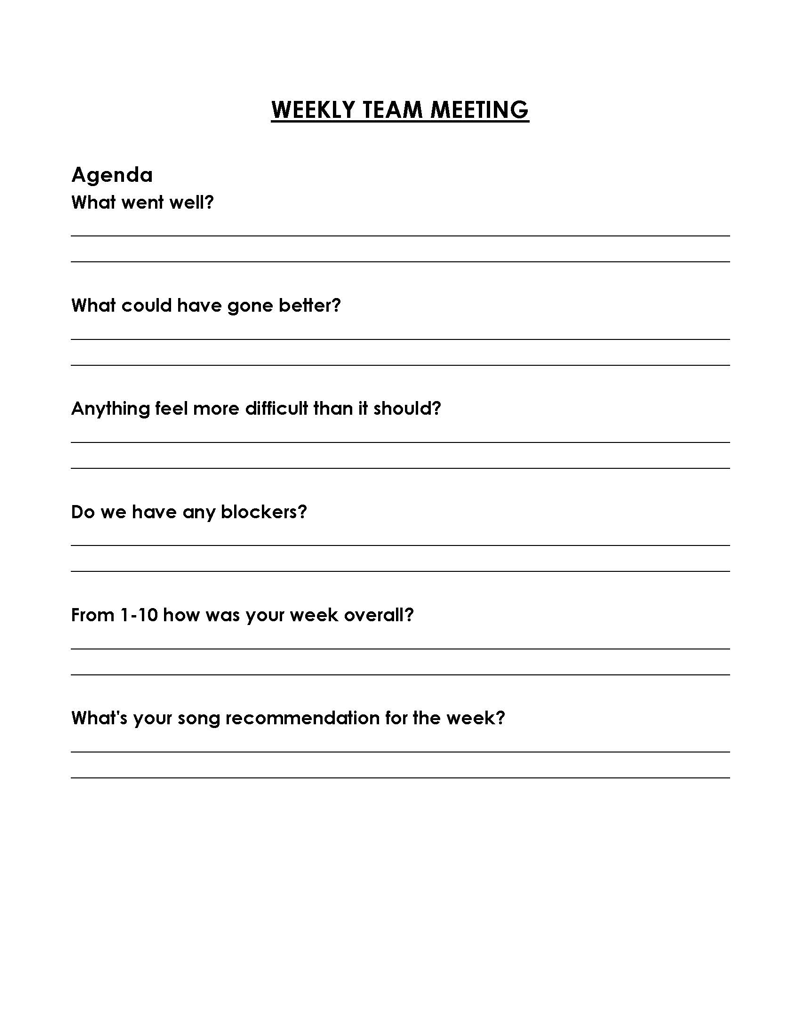
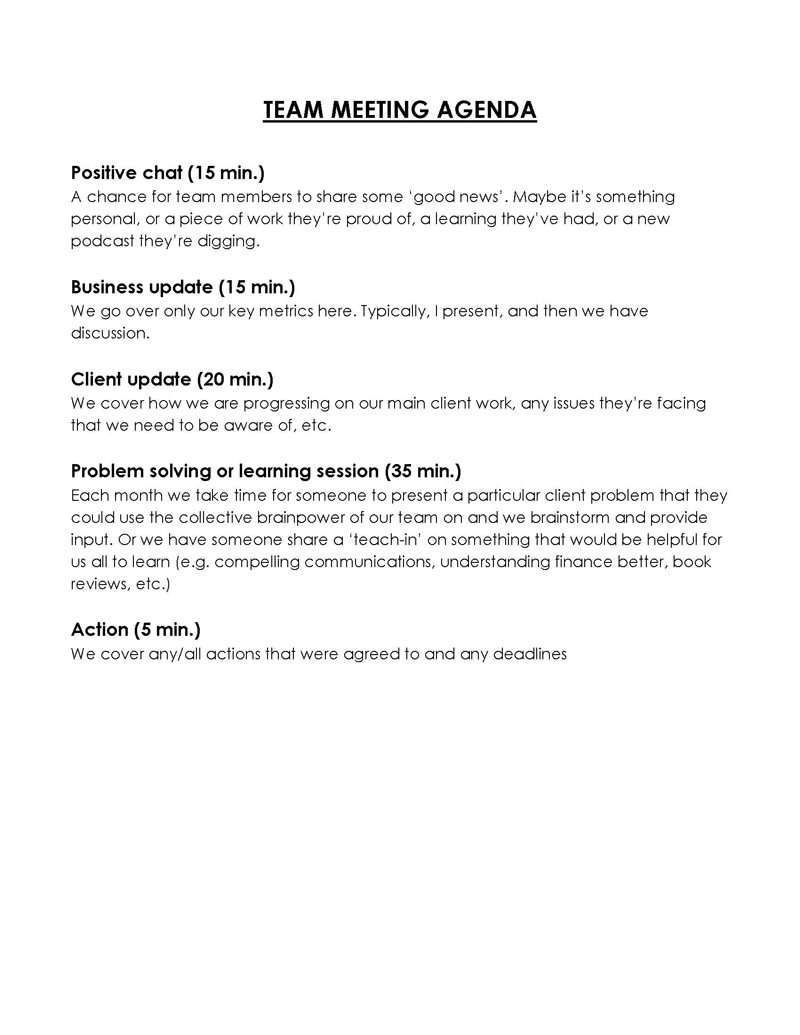
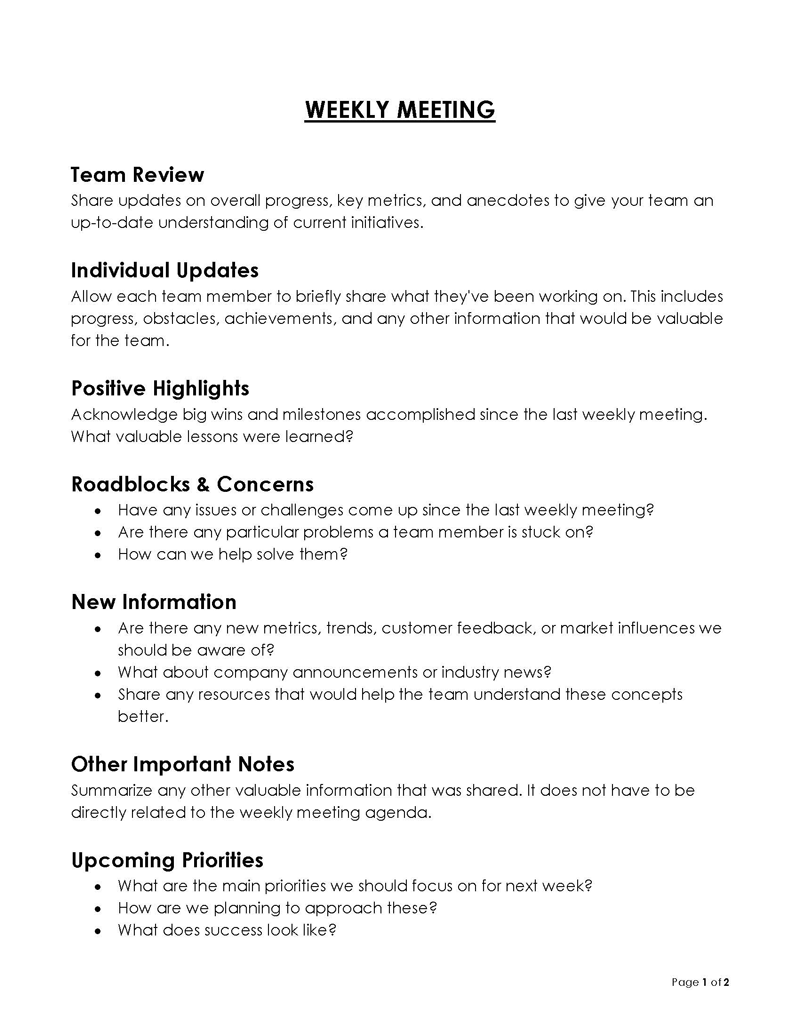
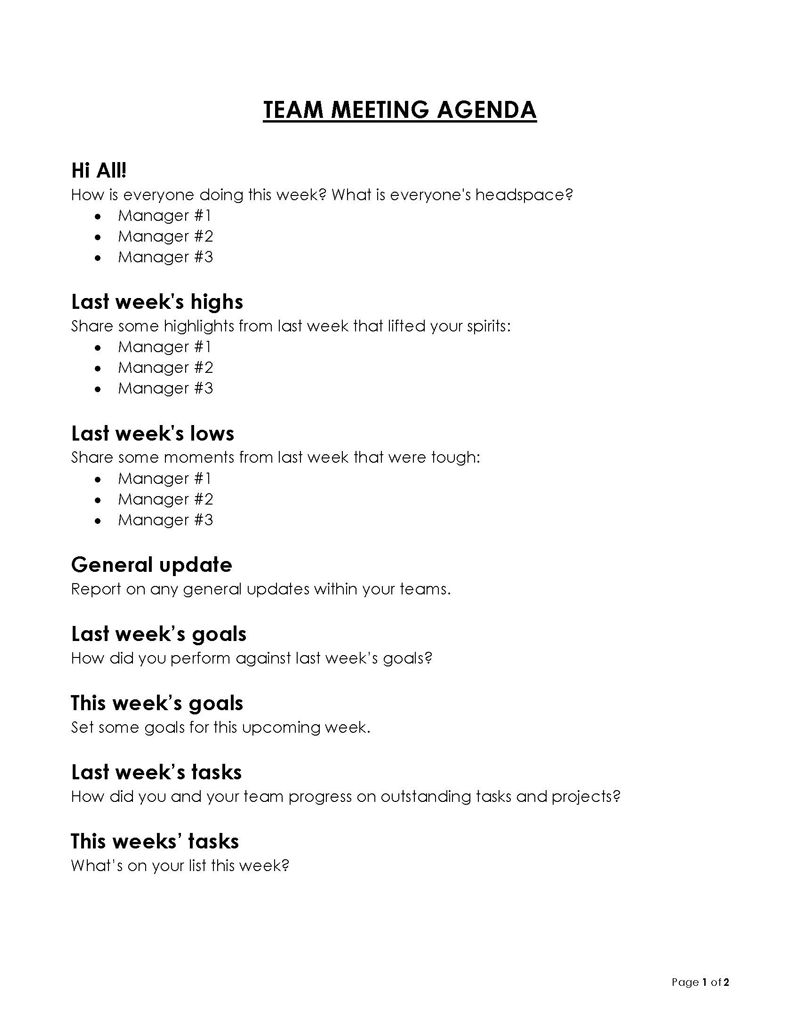
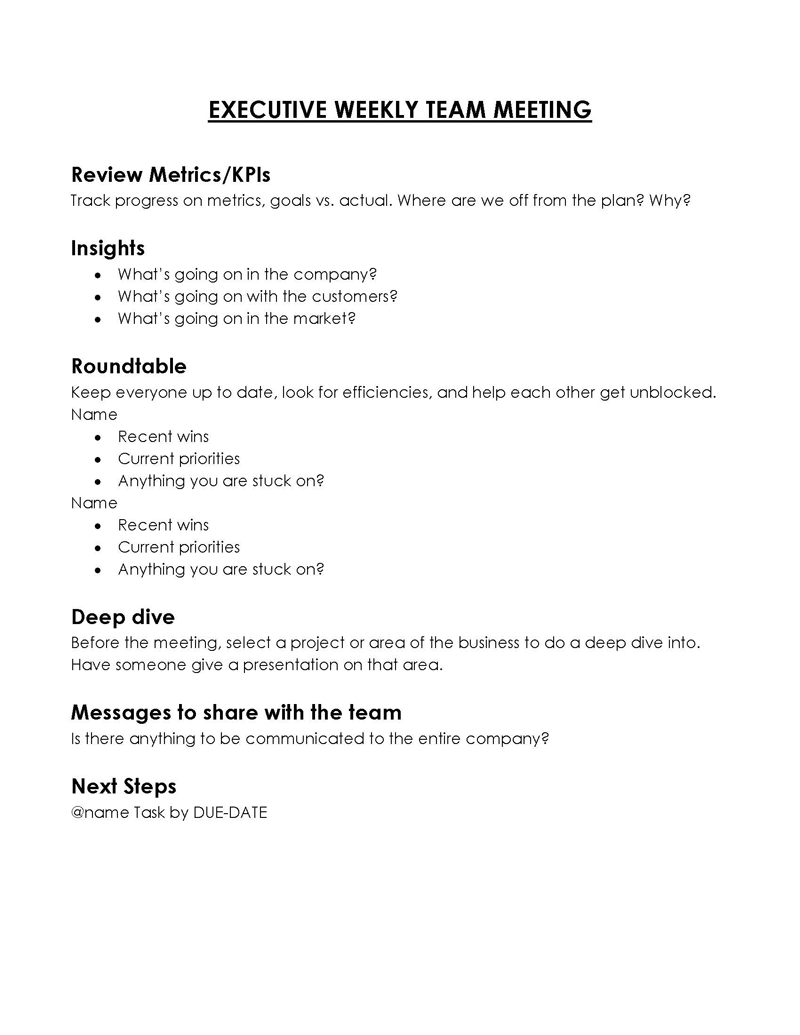
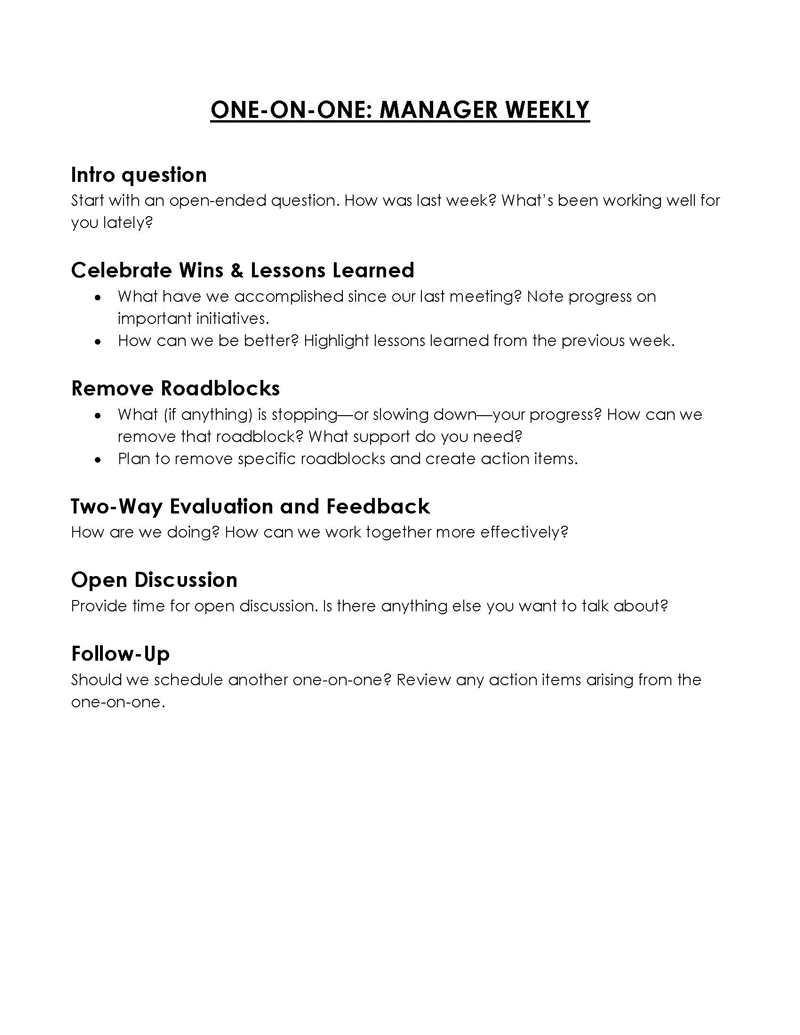
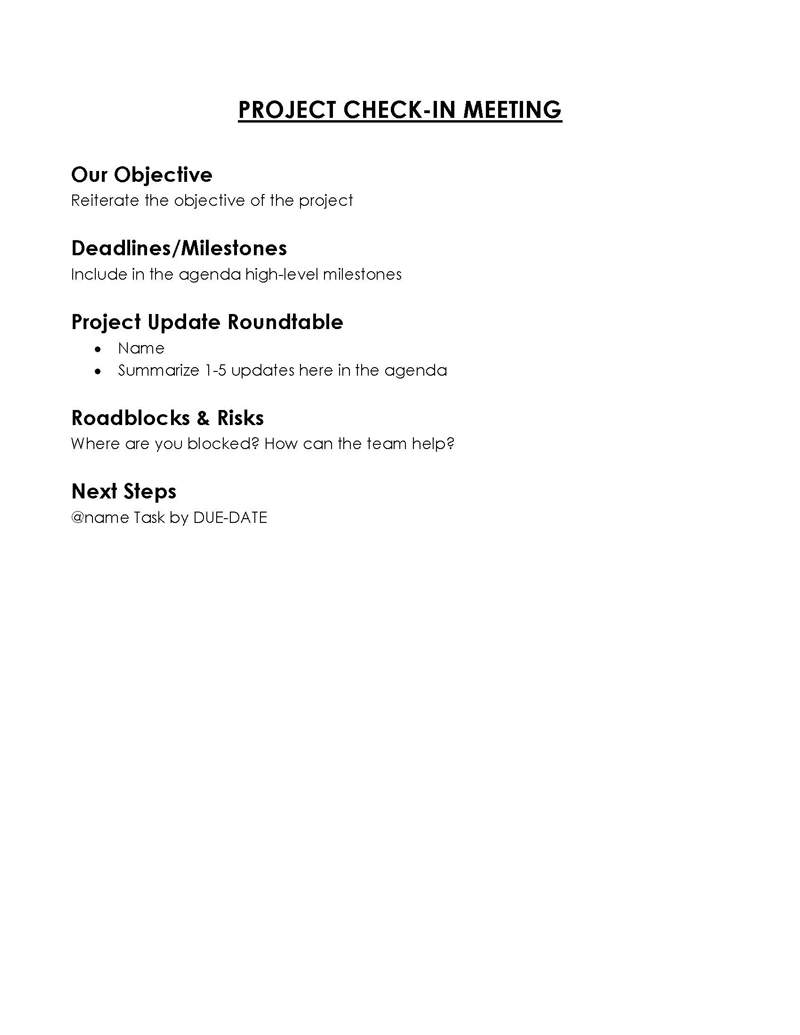
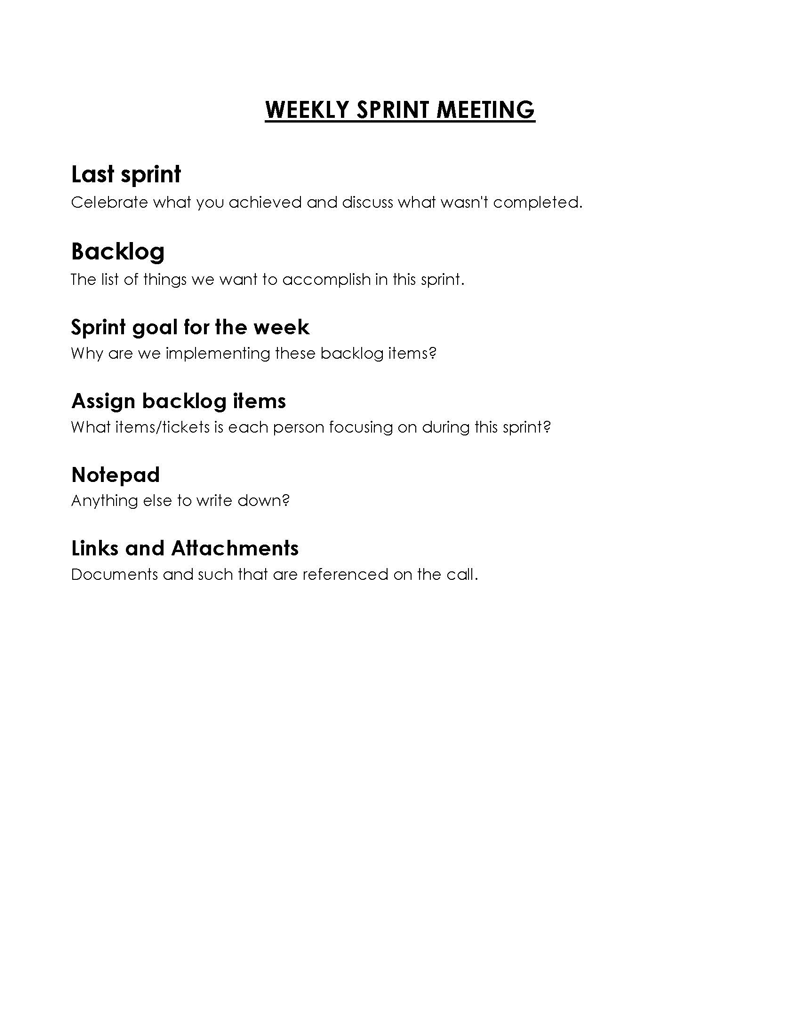
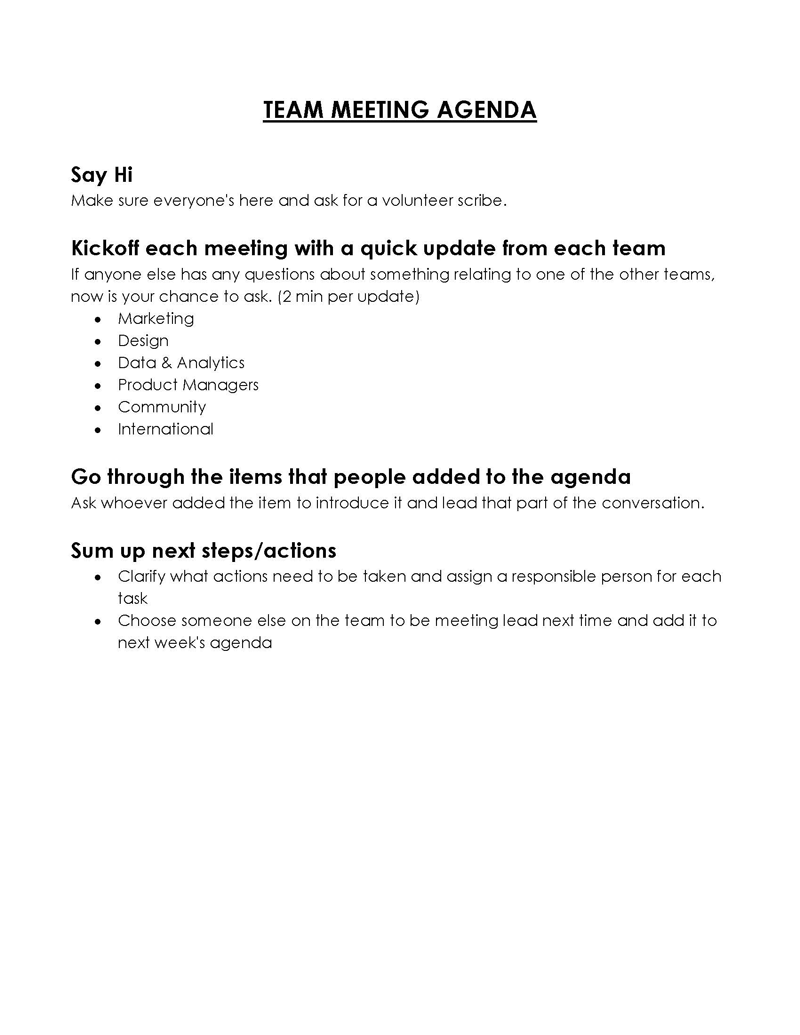
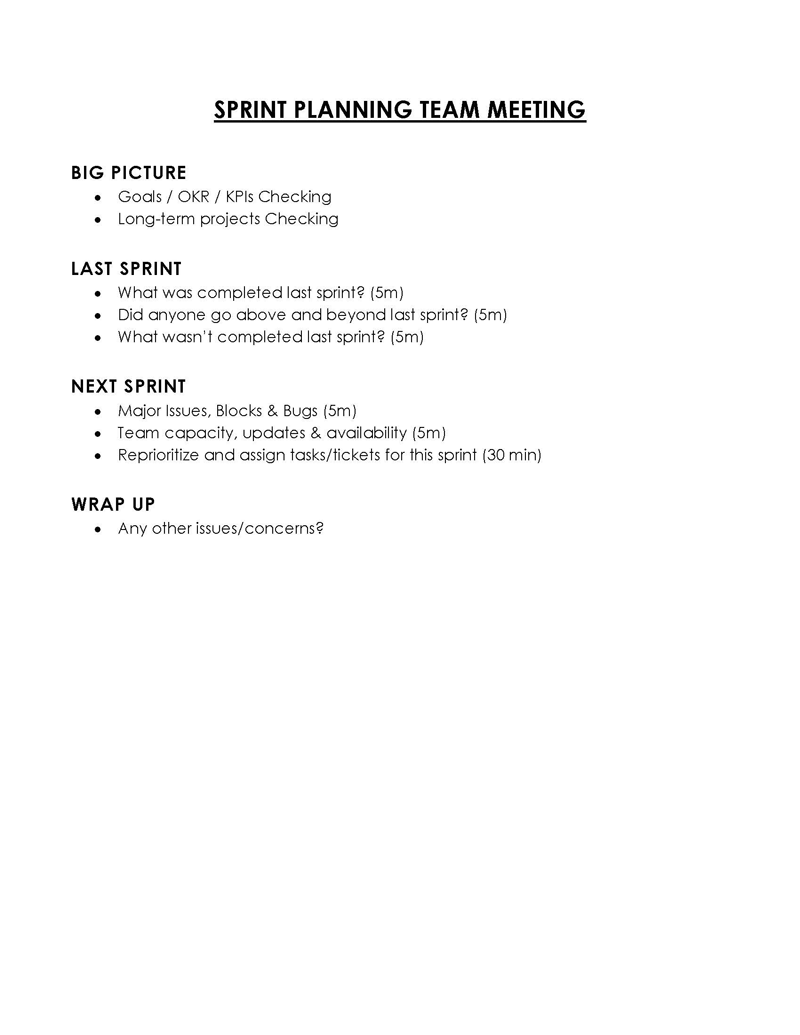
Types of Team Meeting Agenda Templates
There are different types of templates, depending on the purpose of the meeting. Below are some types:
Staff meeting
Staff meetings are a way to share updates and be updated on various issues. They are also a forum for staff members to openly share thoughts, feedback, and concerns.
Leadership meeting
A leadership meeting is when the team leaders of the whole firm discuss essential issues, plans, goals, and deadlines to ensure everything is running smoothly.
Weekly team meeting
Weekly team meetings are where team members gather to discuss issues and find solutions to project-related problems. In addition, team members share their thoughts, suggestions, or concerns about the week’s goals and schedules.
All-hands team meeting
An “all hands meeting” is a company-wide meeting organized by the company’s top executives, in most cases the CEO, and including all the employees. It is usually held to announce significant decisions, changes, and policies within the company. This type of meeting may also be held to discuss new company goals and objectives, share achievements, obtain feedback and questions from employees, and present new technology or features that the employees will be using.
One-on-one meeting
A one-on-one meeting is held between a manager and their employee, usually quarterly, to discuss the employee’s professional development, performance, and objectives.
Brainstorming meeting
Brainstorming meetings are a form of discussion where ideas and concepts are discussed in an open forum for each person to share their thoughts, viewpoints, and insights about a particular topic or idea.
Project kick-off meeting
A project kick-off meeting is used to introduce a new project to the team and members of the organization. This meeting usually occurs after the project chartering process has been completed-before any work commences as part of the project management life cycle.
Project check-in meeting
A project check-in meeting is held when the status of a particular project needs to be presented, reviewed, or brainstormed upon between team members and stakeholders within an organization. This may take place once a week.
Sprint review meeting
A sprint review meeting is an essential part of the Agile project management life cycle, as it is held at the end of each iteration to review and record the project results. The purpose is to ask leading questions to all the members involved (including the project managers, designers, developers, and stakeholders) on what has been achieved during each Sprint, what remains to be done, and how things can be improved.
Daily stand-up meeting
A daily stand-up meeting is a quick overview of what each person will do during the day and how they plan to achieve their tasks. These are also a form of status update and are usually done in person, where team members or project contributors can present their thoughts and findings and provide feedback.
Quarterly strategic meeting
A quarterly strategic meeting is occurs every three months (90 days) to review and update the annual strategic business plan. This type of meeting is usually held at the beginning of the quarter to give management time to make the necessary changes to their plans before the end.
Retrospective meeting
A retrospective meeting is held at the end of a project to review and analyze the work that was done on the project. The purpose of this meeting is to analyze how things were done and why they were done in a certain way. This type of meeting can be used for employee development, problem-solving, and training purposes.
Frequently Asked Questions
Agenda items are a list of topics for discussion. They are prepared before a meeting and usually printed on cards or sheets of paper to facilitate their distribution to the participants.
The best and most recommended way to end an agenda is to allocate time for review at the end of the meeting. The participants can review the progress, evaluate the results, and resolve any conflicts or obstacles during the meeting.
A good agenda is one that clearly defines the objectives of the meeting and provides a clear idea of how these objectives will be achieved. It also helps if it is organized and logical, with each item thoroughly explained.










